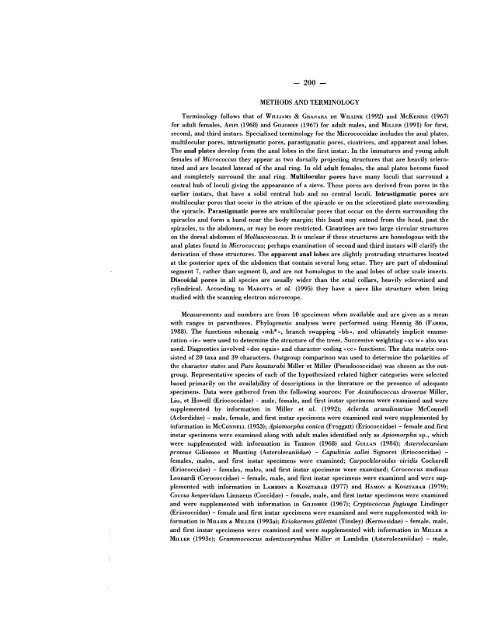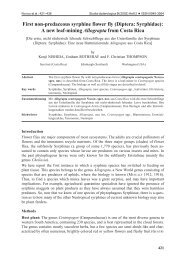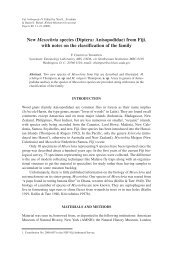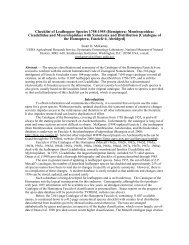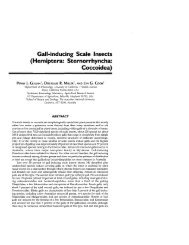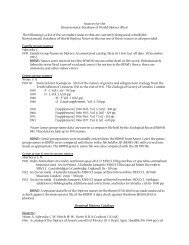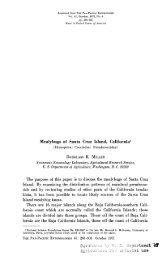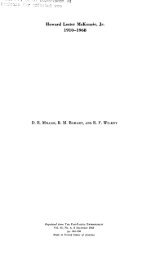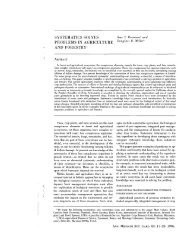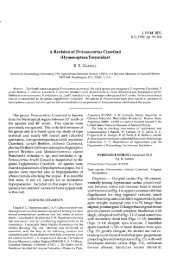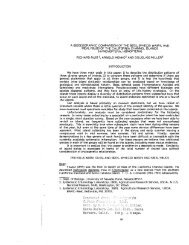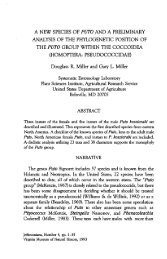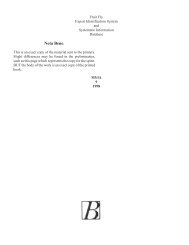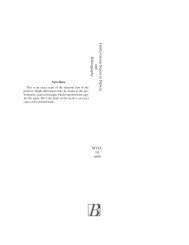Systematic revision of the Family Micrococcidae (Homoptera ...
Systematic revision of the Family Micrococcidae (Homoptera ...
Systematic revision of the Family Micrococcidae (Homoptera ...
Create successful ePaper yourself
Turn your PDF publications into a flip-book with our unique Google optimized e-Paper software.
- 200<br />
METHODS AND TERMINOLOGY<br />
Terminology follows that <strong>of</strong> WILLIAMS & GRANARA DE WILLINK (1992) and McKENZIE (1967)<br />
for adult females, AFlFl (1968) and GlLlOMEE (1967) for adult males, and MILLER (1991) for first,<br />
second, and third instal's. Specialized teI'minology for <strong>the</strong> <strong>Micrococcidae</strong> includes <strong>the</strong> anal plates,<br />
multilocular pores, intrastigmatic pores, parastigmatic pores, cicatrices, and apparent anal lobes.<br />
The anal plates develop from <strong>the</strong> anal lobes in <strong>the</strong> first instar. In <strong>the</strong> immatures and young adult<br />
females <strong>of</strong> Micrococcus <strong>the</strong>y appear as two dorsally projecting structures that are heavily sclerotized<br />
and are located laterad <strong>of</strong> <strong>the</strong> anal ring. In old adult females, <strong>the</strong> anal plates become fused<br />
and completely surround <strong>the</strong> anal ring. Multilocular pores have many loculi that surround a<br />
central hub <strong>of</strong> loculi giving <strong>the</strong> appearance <strong>of</strong> a sieve. These pores are derived from pores in <strong>the</strong><br />
earlier instal's, that have a solid central hub and no central loculi. Intrastigmatic pores are<br />
multilocular pores that occur in <strong>the</strong> atrium <strong>of</strong> <strong>the</strong> spiracle or on <strong>the</strong> sclerotized plate surrounding<br />
<strong>the</strong> spiracle. Parastigmatic pores are multilocular pores that occur on <strong>the</strong> derm surrounding <strong>the</strong><br />
spiracles and form a band near <strong>the</strong> body margin; this band may extend from <strong>the</strong> head, past <strong>the</strong><br />
spiracles, to <strong>the</strong> abdomen, or may be more restricted. Cicatrices are two large circular structures<br />
on <strong>the</strong> dorsal abdomen <strong>of</strong> Molluscococcus. It is unclear if <strong>the</strong>se structures are homologous with <strong>the</strong><br />
anal plates found in Micrococcus; perhaps examination <strong>of</strong> second and third instal's will clarify <strong>the</strong><br />
derivation <strong>of</strong> <strong>the</strong>se structures. The apparent anal lobes are slightly protruding structures located<br />
at <strong>the</strong> posterior apex <strong>of</strong> <strong>the</strong> abdomen that contain several long setae. They are part <strong>of</strong> abdominal<br />
segment 7, ra<strong>the</strong>r than segment 8, and are not homologus to <strong>the</strong> anal lobes <strong>of</strong> o<strong>the</strong>r scale insects.<br />
Discoidal pores in all species are usually wider than <strong>the</strong> setal collars, heavily sclerotized and<br />
cylindrical. According to MAROTIA et al. (1995) <strong>the</strong>y have a sieve like structure when being<br />
studied with <strong>the</strong> scanning electron microscope.<br />
Measurements and numbers are from 10 specimens when available and are given as a mean<br />
with ranges in paren<strong>the</strong>ses. Phylogenetic analyses were performed using Hennig 86 (FARRIS,<br />
1988). The functions mhennig «mh*», branch swapping «bb», and ultimately implicit enumeration<br />


